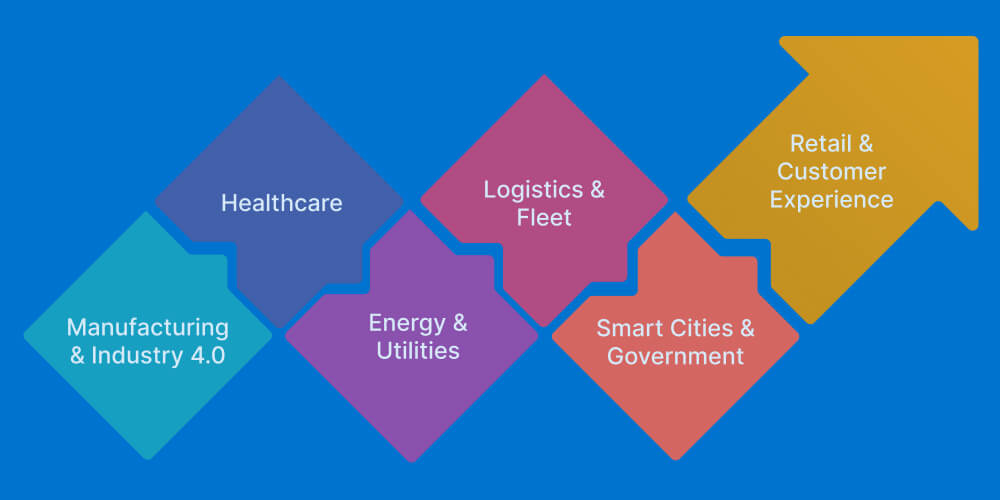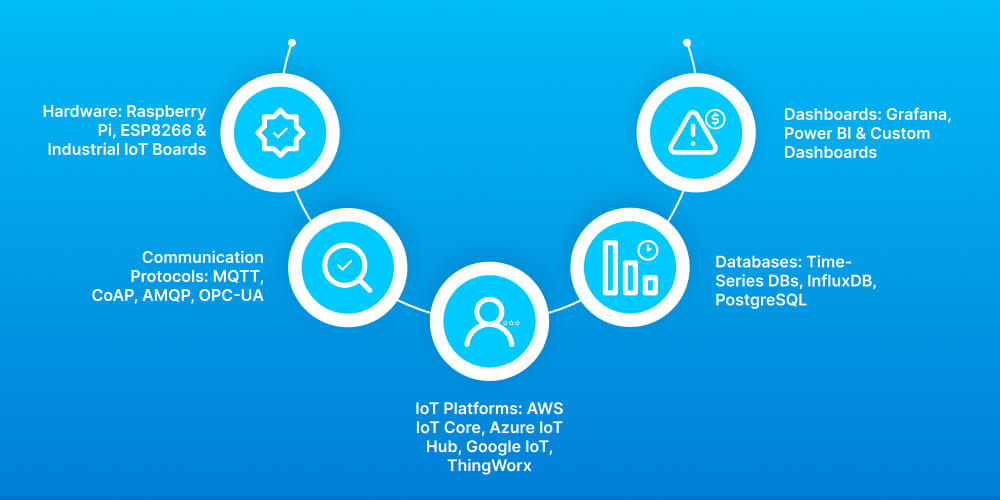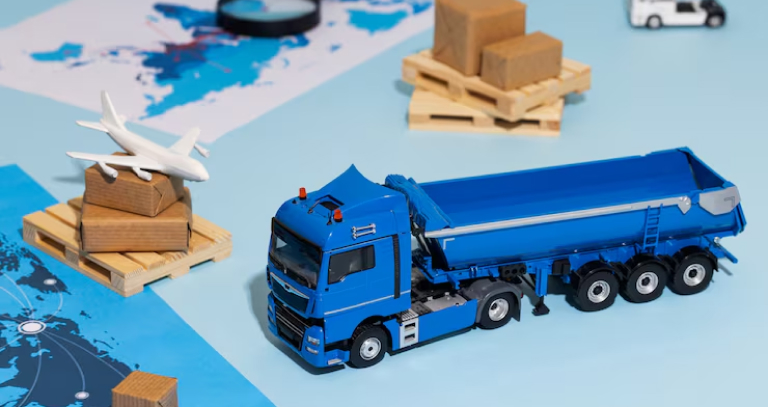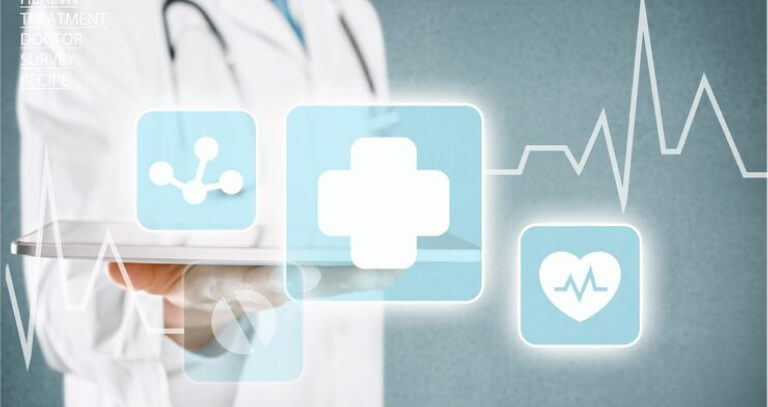Ultimate Guide for IoT Application Development
Ditstek Blogs
IoT application development is becoming a core driver of digital transformation for Canadian enterprises. By connecting physical assets, machines, vehicles, medical equipment, and infrastructure to intelligent software systems, organizations gain real-time data, automation, and predictive insights.
Industries across Canada are already benefiting: manufacturing is reducing downtime, energy companies are monitoring remote assets, logistics providers are improving fleet visibility, healthcare systems are scaling remote monitoring, and smart cities are enhancing public services.
With IoT app development, businesses achieve cost optimization, safer operations, and improved customer experience. In a competitive market, Internet of Things application development empowers Canadian companies to innovate faster and operate smarter through data-driven decision making.
Understanding IoT Applications
An IoT application is a connected software system that collects data from physical devices through sensors and transfers it over secure networks to cloud platforms for processing. Through IoT application development, businesses can monitor assets, track performance, automate workflows, and make decisions using real-time analytics.
Every solution involves key components: hardware sensors, connectivity technologies, cloud storage, data analytics, and an intuitive user interface such as a web or mobile dashboard. Modern IoT app development enables companies to control devices remotely, predict failures, and improve safety. As internet of things application development expands across Canada, organizations are embracing IoT development to reduce costs and operate smarter.
Core Components of an IoT Solution
A successful IoT application development project integrates multiple layers of technology that work seamlessly together. It starts with device hardware and sensors that capture real-time data from machines, vehicles, or infrastructure. This data travels via secure connectivity options such as 4G/5G, LPWAN, Wi-Fi, or BLE. Through cloud and edge computing, information is processed instantly and routed through efficient data pipelines and analytics.
Security layers protect devices, networks, and stored data, while intuitive user dashboards or mobile apps provide insights and control. For Canadian businesses, modern IoT app development and internet of things application development empower smarter decisions and scalable digital ecosystems through intelligent IoT development.
How Smart Is Your Infrastructure?
Unlock automation, efficiency, and real-time insights with a tailored IoT development roadmap built for your business.
Why IoT Is Transforming Canadian Businesses
Across Canada, IoT application development is reshaping industries by improving efficiency, asset visibility, and data-driven operations. Companies gain real-time asset tracking, lower maintenance costs, safer work environments, and faster decision-making. Predictive analytics helps prevent equipment failures, while automation reduces manual labor and human error. From smart farming in Alberta to fleet telematics in Ontario and Industry 4.0 manufacturing in British Columbia, the results are measurable and scalable.
Key transformations include:
- Operational efficiency and automated workflows
- Predictive maintenance analytics for machinery
- Real-time logistics and fleet visibility
- Stronger regulatory compliance and workplace safety
- Better planning through supply chain management system development
Through advanced IoT app development, Canadian organizations are experiencing improved productivity, cost optimization, and long-term growth driven by intelligent IoT development and real-time insights gained from internet of things application development.
Use Cases Across Canadian Industries

Manufacturing & Industry 4.0
Canadian manufacturers are adopting IoT application development to modernize production floors and reduce downtime. Through machine monitoring, real-time sensors detect equipment irregularities before failures occur, enabling predictive maintenance and extending asset life. Automation powered by smart robotics, digital twins, and cloud analytics helps factories optimize output with fewer interruptions.
In British Columbia and Ontario, several automotive and heavy-equipment manufacturers now rely on IoT app development to achieve safer operations, lower energy consumption, and precise quality control. As internet of things application development grows across Canada, Industry 4.0 environments benefit from faster decision-making, improved productivity, and scalable IoT development.
Healthcare
In healthcare, IoT application development enables smarter patient monitoring, faster data sharing, and better medical device management. Hospitals and clinics use smart wearables and connected devices to monitor heart rate, oxygen levels, blood pressure, and glucose in real time, reducing emergency visits and enabling early intervention. Equipment tracking minimizes losses, while analytics support doctors with more accurate diagnosis.
Canadian provinces like Ontario and Alberta are adopting IoT app development solutions for remote patient care, hospital asset monitoring, and telehealth platforms. Through internet of things application development, the healthcare sector improves patient outcomes, reduces operational costs, and strengthens preventive care.
Energy & Utilities
Energy and utility companies across Canada rely on IoT development to modernize infrastructure and reduce operational risks. Smart grids monitor electricity distribution, prevent outages, and detect faults instantly. Renewable energy farms use IoT application development to track turbine or solar panel performance and optimize maintenance schedules.
Oil and gas providers use sensors for pipeline monitoring, leak detection, and worker safety. Provinces like Alberta and Saskatchewan have adopted IoT app development for real-time asset management in remote fields. With internet of things application development, the sector reduces energy loss, enhances safety compliance, and supports sustainable energy strategies.
Logistics & Fleet
The logistics and transportation industry in Canada benefits significantly from IoT application development. GPS and telematics solutions provide real-time fleet tracking, route optimization, fuel monitoring, and driver safety analytics. Cold chain operators use smart temperature sensors to protect food, pharmaceuticals, and perishable goods.
Ontario-based carriers and retailers increasingly invest in IoT app development to achieve timely deliveries and lower fuel waste. When combined with a supply chain management system development, businesses gain end-to-end shipment visibility. Through internet of things application development, logistics companies reduce manual coordination, avoid losses, and improve customer delivery reliability using connected IoT development platforms.
Smart Cities & Government
Across Canada, provincial and municipal governments are investing in IoT development to improve citizen services and reduce infrastructure costs. Smart traffic systems reduce congestion, while connected street lighting lowers electricity consumption. Waste collection vehicles use sensors to optimize pickup routes.
Emergency response teams monitor environmental conditions, air quality, and disaster alerts through IoT application development. Cities like Vancouver and Toronto are expanding digital infrastructure with IoT app development, creating safer neighborhoods and sustainable public systems. Through internet of things application development, smart cities improve mobility, reduce pollution, and support data-driven governance.
Retail & Customer Experience
Retailers in Canada are using IoT application development to create personalized customer experiences and optimize store operations. Smart shelves and RFID scanning automate inventory tracking, reducing stock-out issues and human error. Footfall analytics help store managers understand shopping patterns and adjust layouts or promotions.
Cold storage monitoring protects food quality in supermarkets across Ontario and Quebec. With IoT app development, stores connect POS systems, sensors, and digital signage for seamless in-store journeys. As internet of things application development expands, Canadian retailers gain higher revenue, reduced waste, and improved customer satisfaction—all strengthened by scalable IoT development strategies.
Ready to Build Your IoT Ecosystem?
Turn connected assets into competitive advantage with end-to-end IoT application development and intelligent cloud integration.
Key Steps in IoT Application Development

Business Requirement Discovery
Successful IoT application development begins with a crystal-clear understanding of your business goals. Canadian enterprises typically start by identifying automation gaps, operational bottlenecks, compliance needs, and measurable KPIs such as cost reduction, downtime prevention, asset visibility, energy efficiency, or predictive maintenance outcomes.
During this phase, consultants map user journeys, define data sources, establish the expected ROI, and determine which IoT features deliver the maximum operational advantage. This ensures the solution is not just technically sound, but commercially viable and scalable for real-world deployment.
Hardware & Sensor Selection
Once goals are established, the next step is choosing the right sensors, devices, and gateways. IoT applications may require industrial-grade hardware for harsh, cold, or high-vibration Canadian environments such as mining, logistics yards, agriculture, or manufacturing plants.
Selection is based on accuracy, durability, latency, battery life, data sampling rate, and resilience to weather. For consumer-centric needs—like smart homes or retail—cost-optimized compact sensors may be used. Proper device selection lays the foundation for accurate data collection, smarter analytics, and long-term maintenance reliability.
IoT Platform & Cloud Setup
A powerful backend is the backbone of every IoT application. Most Canadian companies choose well-established platforms like AWS IoT, Azure IoT Hub, or Google Cloud IoT, while enterprises with strict data residency or compliance requirements may opt for private cloud deployments.
Cloud architecture supports secure device connectivity, multi-tenant access, real-time dashboards, user permissions, and encrypted data pipelines. Integrations for ML-based anomaly detection, predictive maintenance, and automated reporting are also configured at this stage to ensure a future-ready IoT ecosystem.
Connectivity Strategy
IoT application performance depends heavily on the right connectivity choice. For high-speed data transfer or autonomous equipment, 5G may be ideal. For indoor automation, like warehousing and manufacturing, Wi-Fi delivers reliable throughput.
Remote facilities such as farms or oilfields often rely on LPWAN networks (LoRaWAN/NB-IoT) for long-range, low-power data transmission. Zigbee supports low-energy mesh networks commonly used in smart buildings. The selection is driven by data volume, energy consumption, latency needs, mobility, and coverage area. The correct connectivity ensures seamless communication between devices, cloud systems, and end-user dashboards.
Data Architecture
A scalable IoT solution requires well-structured data architecture. Businesses decide how much processing should happen on edge devices (fast, offline decision-making) versus cloud processing (high-capacity analytics and storage). Real-time dashboards give technicians, operators, and management a single source of truth on performance, alerts, usage, and predictive insights.
A flexible architecture also supports digital twins, machine learning, automated alerts, and compliance-ready reporting, helping Canadian organizations improve operational visibility and data-driven decisions.
Application Development
This step involves building the user-facing software—the web app, mobile app, or desktop dashboard. The application allows users to track devices, monitor KPIs, generate reports, visualize sensor data, trigger alerts, and control devices remotely.
API integrations connect the IoT platform with existing ERP, fleet management, CRM, billing, or energy management systems. Developers also ensure role-based authentication, audit trails, secure access, encryption, and compliance based on Canadian privacy standards. The result is a seamless, intuitive interface that makes complex IoT data effortless to manage.
Testing & Pilot Deployment
Before full rollout, the IoT system undergoes rigorous testing. Stress tests ensure performance under heavy data loads, while cybersecurity testing validates encryption, identity management, firmware safety, and attack-surface protection.
Field testing in real environmental conditions verifies signal strength, battery life, weather tolerance, and sensor accuracy. A pilot deployment in a small location or fleet ensures the solution works reliably before scaling across multiple sites, warehouses, or vehicles.
Scaling & Device Fleet Management
Once the pilot succeeds, the IoT application is expanded across locations, equipment groups, or customer environments. Device fleet management is essential for long-term success. Businesses rely on OTA (Over-the-air) firmware updates to fix bugs, add new features, and maintain security standards without physical visits.
Centralized monitoring identifies failing sensors, connectivity issues, tampering, or abnormal patterns. Remote configuration eliminates manual labour and ensures fast adoption across large environments—making national-scale deployments viable and operationally cost-efficient.
Tech Stack: Tools, Platforms & Frameworks

Modern IoT application development relies on a reliable and scalable tech stack that supports real-time data processing, remote monitoring, and secure automation. For Canadian businesses moving toward Industry 4.0, the right combination of hardware, platforms, protocols, and analytics tools ensures better performance, long-term scalability, and compliance with data security expectations.
1. Hardware: Raspberry Pi, ESP8266 & Industrial IoT Boards
IoT hardware is the foundation of every connected system. Raspberry Pi boards allow rapid prototyping and edge computing, while ESP8266 microcontrollers are ideal for cost-friendly Wi-Fi–enabled IoT devices.
For rugged Canadian environments like mining, farming, manufacturing, or energy operations, industrial IoT boards offer higher durability, extended temperature tolerance, and longer lifecycle. Choosing the correct hardware ensures accurate data collection, reduced maintenance, and stable performance even in harsh conditions.
2. Communication Protocols: MQTT, CoAP, AMQP, OPC-UA
Communication protocols allow devices and cloud platforms to exchange data efficiently. MQTT is lightweight and perfect for real-time monitoring or remote tracking. CoAP enables low-power devices to send small data packets efficiently. AMQP is often used in enterprise-grade projects that require advanced routing and message queuing.
OPC-UA is widely adopted in industrial automation, production lines, and SCADA-based environments. The right protocol helps maintain security, low latency, and reliable device-to-cloud communication across Canadian facilities and distributed sites.
3. IoT Platforms: AWS IoT Core, Azure IoT Hub, Google IoT, ThingWorx
A cloud IoT platform manages device onboarding, data processing, analytics, alerts, digital twins, and integrations. AWS IoT Core and Azure IoT Hub are popular across Canada due to security, scalability, and native AI/ML features.
Google Cloud IoT suits high-volume analytics and AI-driven automation. ThingWorx is widely used for industrial IoT application development, smart manufacturing, asset tracking, and connected operations. These platforms provide encryption, identity management, OTA updates, and enterprise-level compliance support.
4. Databases: Time-Series DBs, InfluxDB, PostgreSQL
IoT systems generate massive data streams, requiring efficient storage and querying. Time-series databases and InfluxDB handle high-frequency sensor data—ideal for telemetry, equipment health, and energy analytics.
PostgreSQL supports structured business data like users, transactions, equipment profiles, or ERP-linked workflows. The combination ensures fast insights, scalable storage, and simplified business reporting—critical for Canadian organizations focused on predictive maintenance, automation, and regulatory reporting.
5. Dashboards: Grafana, Power BI & Custom Dashboards
Dashboards transform IoT data into actionable intelligence. Grafana enables real-time visualizations and alerting for field technicians or operations teams. Power BI connects IoT analytics with business KPIs, financial metrics, and decision-making dashboards.
Many enterprises prefer custom dashboards to manage devices, send alerts, track energy usage, automate workflows, or generate compliance reports. User-friendly dashboards help Canadian businesses improve transparency, reduce downtime, and enhance data-driven operations.
Want to Modernize Legacy Systems?
Bridge old infrastructure with modern IoT platforms to accelerate digital transformation without disrupting current operations.
IoT Cybersecurity: A Critical Consideration
Security is one of the most important layers in IoT application development, especially when businesses rely on real-time data and connected devices. Securing IoT ecosystems involves device authentication, encrypted communication, and strict user access control.
Data encryption standards such as AES and TLS prevent unauthorized interception, while network isolation ensures that IoT devices are separated from core IT systems. Firmware signing protects devices from malicious updates, and regular penetration testing identifies risks before attackers do.
Canadian businesses must also consider compliance, including PIPEDA and HIPAA for healthcare IoT app development, ensuring that sensitive data is protected at every stage.
Cost Factors in IoT App Development
Budgeting for internet of things application development depends on multiple cost components. Hardware and sensors are typically the first expense, followed by connectivity and cloud usage.
Development, API integrations, and dashboard creation form a major share of total cost. Ongoing data storage, analytics processing, and IoT cybersecurity add long-term operational spending. Organizations must also plan for maintenance, OTA updates, and device management.
Pricing models vary from fixed scope development to subscription-based plans or pay-per-device billing. Canadian businesses often prefer consumption-based pricing because it scales as device fleets grow. The right investment brings efficiency, automation, and faster ROI.
Common Challenges & How to Overcome Them
During IoT development, companies often face obstacles like choosing between 5G, Wi-Fi, or LPWAN connectivity, handling data overload, or integrating with legacy systems. Many older systems require application modernization before they connect smoothly with IoT infrastructure. Scalability is another concern—device fleets grow, data increases, and analytics pipelines must expand. Cybersecurity gaps create additional risk, particularly in healthcare, logistics, and critical infrastructure. The key is strategic planning: secure protocols, edge computing for data reduction, user-focused dashboards, and structured onboarding. Smooth user adoption ensures long-term value and operational success in IoT app development.
How to Select the Right IoT Development Partner
Choosing the right IoT development partner determines project quality, time-to-market, and long-term ROI. Canadian enterprises should look for industry experience, proven case studies, and strong cybersecurity practices. Cloud and DevOps capability is essential, particularly for AWS, Azure, or Google IoT solutions. Partners with expertise in AI software development or AI chatbot development services can deliver advanced automation and predictive intelligence. Understanding Canadian data compliance, infrastructure requirements, and on-ground deployment challenges ensures smoother execution. A transparent strategy, PoC-driven approach, and real-time support define a reliable IoT application development partner.
How Intelligent Is Your Data?
Transform real-time data into strategic value through custom IoT app development tailored to your industry and KPIs.
Future of IoT in Canada
The future of internet of things application development in Canada is fueled by 5G networks, AI analytics, and real-time automation. Industries like energy, logistics, healthcare, agriculture, and retail are already adopting IoT development to improve efficiency and reduce operational costs. Edge computing brings faster local processing, while digital twins and augmented reality support advanced monitoring and simulation. Sustainability-focused IoT solutions help optimize fuel usage, water management, and waste reduction. As IoT merges with AI software development and application modernization, Canadian businesses will continue moving toward smarter, data-driven operations with stronger competitiveness on a global scale.
Conclusion
IoT application development is no longer experimental—it is a core driver of efficiency, automation, and competitive advantage for Canadian businesses. From manufacturing floors and connected healthcare to logistics visibility and smart energy systems, IoT app development delivers real-time intelligence that transforms everyday operations. With the right IoT roadmap, companies gain predictive maintenance, reduced downtime, safer workplaces, and optimized costs, creating measurable impact across every department.
The next step for Canadian enterprises is digital transformation driven by data, automation, and connectivity. Whether you want to modernize legacy systems, integrate analytics, or build a full-scale connected ecosystem, expert guidance helps reduce risk and accelerates results.
Ready to explore the potential of IoT for your business?
Book a consultation with Ditstek Innovations for a free feasibility assessment, architecture recommendation, or pilot deployment plan. Our team specializes in IoT development, secure cloud integration, and industry-specific solutions built for Canada’s operational landscape.
Let’s turn your connected vision into a scalable reality.

Dinesh Thakur
21+ years of IT software development experience in different domains like Business Automation, Healthcare, Retail, Workflow automation, Transportation and logistics, Compliance, Risk Mitigation, POS, etc. Hands-on experience in dealing with overseas clients and providing them with an apt solution to their business needs.
Recent Posts
Get in touch










